Views: 0
Hypochlorous Acid Is a Disinfectant with Some Medicinal Properties, but It’s Too Soon to Tell If It Can Benefit People with Acne

The Essential Info
What It Is: Hypochlorous acid naturally occurs in the human body, where it helps fight infection. Manufacturers of household cleansers also chemically synthesize it and include it in their products. It is also the disinfectant found in chlorinated swimming pools. And, because it can treat skin rashes, it is included in topical rash treatments as well.
How It Works: Research shows that hypochlorous acid can:
- Kill bacteria (including acne bacteria)
- Help to heal wounds and scars (medically speaking, acne lesions are small wounds)
- Reduce itching
These medicinal properties make hypochlorous acid a promising candidate for further research as an acne treatment. However, as yet there is no direct evidence that it can help with acne. Let’s hope we see some research into it in the near future. If and when it is studied, I’ll be sure to bring the results to you.

The Science
Hypochlorous acid is a weak acid that effectively kills bacteria, viruses, and fungi, making it a powerful sanitizer.
Because of this, hypochlorous acid is an active ingredient in many household cleaning products. It is also the disinfectant found in chlorinated swimming pools. These everyday uses of hypochlorous acid are actually mimicking its function in the human body. The body naturally produces hypochlorous acid to fight infections.1-4
In addition to its antibacterial activity, hypochlorous acid can help relieve itching.
Because of these medicinal properties, the U.S. Food and Drug Administration (FDA) has approved certain hypochlorous acid products for cleaning wounds during surgery and for the relief of pain and itch caused by broken skin and rash.5
Since bacteria play a role in acne, and itching often accompanies acne flare-ups, some people wonder whether hypochlorous acid could help fight acne as well. No studies to date have tested hypochlorous acid on acne patients to determine whether it might be a useful and risk-free treatment. However, the evidence on the medicinal properties of hypochlorous acid gives us reason to be cautiously optimistic. Still, without research specifically on hypochlorous acid and acne, it is far too early to recommend hypochlorous acid as an acne remedy.
How Hypochlorous Acid Might Help with Acne
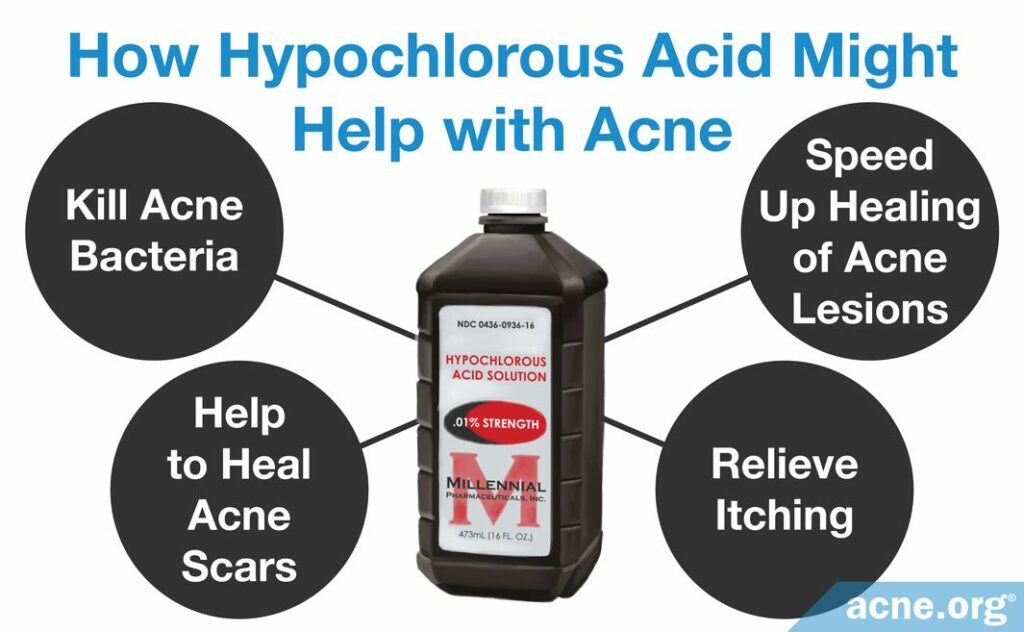
Research suggests that hypochlorous acid might be useful for people with acne because of its ability to:
- Kill acne bacteria: Hypochlorous acid can kill C. acnes, the type of bacteria that plays a role in making acne worse.
- Speed up healing of acne lesions: Hypochlorous acid may promote the healing of small wounds like acne lesions by killing bacteria that delay the healing process.
- Help to heal acne scars: Hypochlorous acid might help reduce raised scars, which can sometimes form after acne lesions have healed.
- Relieve itching: Certain concentrations of hypochlorous acid may relieve itching, which is a common symptom of acne.6-12
But remember, researchers have never actually tested hypochlorous acid on people with acne, so all the evidence we have is indirect.
So how confident are we that hypochlorous acid can really do all of the above? Let’s take a closer look at the evidence.
Evidence that hypochlorous acid can kill acne bacteria
Scientists and doctors have long known that hypochlorous acid is a powerful antibacterial substance. In fact, our bodies naturally use hypochlorous acid to fight off bacteria. When harmful bacteria invades the body, certain immune system cells respond by producing hypochlorous acid, enough to kill millions of bacterial strains in a matter of minutes.13
But how well can hypochlorous acid specifically kill C. acnes, the type of bacteria that makes acne worse? In 2018, scientists performed a study to compare the ability of hypochlorous acid and three other common antiseptics, such as rubbing alcohol, to kill C. acnes in a petri dish. The researchers concluded that hypochlorous acid was at least as good as or better than the three other antiseptics at killing acne bacteria. They also found that it worked immediately, taking less than one minute to kill the bacteria. The researchers wrote, “Hypochlorous acid…had an immediate microbicidal effect on all organisms evaluated when compared with the 3 commonly used skin antiseptics. This highlights its use as a potential alternative skin cleanser.”6
Expand to read details of study

The study was published in 2018 in the journal Dermatologic Surgery. The researchers tested the ability of 0.01% hypochlorous acid, 5% povidone iodine, 4% chlorhexidine gluconate, and 70% isopropyl alcohol to kill various common skin bacteria types, including C. acnes, in a petri dish. They found that, while all the antiseptics were effective, hypochlorous acid killed all the tested types of bacteria in under a minute, whereas some of the other antiseptics required up to two minutes.6
Because the researchers tested hypochlorous acid at a concentration of 0.01%, all we can say at this point is that this concentration can kill acne bacteria. It is impossible to say whether lower concentrations of hypochlorous acid would work equally well.
The fact that hypochlorous acid can kill acne bacteria is encouraging, because it provides a potential alternative to topical antibiotics, which doctors often prescribe for acne. The problem with antibiotics is that over time, bacteria can become resistant to them, which means that the antibiotics start to fail not only against acne, but against other, more serious infections. Fortunately, bacteria are unable to develop resistance to hypochlorous acid. As the authors of another 2018 article in Dermatologic Surgery wrote, “This makes [hypochlorous acid] a particularly attractive option…at a time when antibiotic resistance is a growing concern.”5
Evidence that hypochlorous acid may speed up the healing of acne lesions
While scientists have never tested hypochlorous acid specifically on acne lesions, they have looked at its ability to speed up healing of other wounds. In medical terms, an acne lesion is a type of small wound.
When it comes to the healing of wounds, bacteria often get in the way by producing something called bacterial biofilms. Bacterial biofilms are basically thin sheets of bacteria encased in a protective layer of complex sugars and proteins. Bacteria use their biofilms like a fortress to hide in and grow, making antibiotics unable to get in. Research shows that the acne bacteria C. acnes can also form biofilms, which is part of the reason why acne can become resistant to antibiotic treatment.7
One case study published in 2012 tested hypochlorous acid on five patients with chronic wounds to determine whether it can disrupt bacterial biofilms and thus help wounds to heal faster. The researchers looked at several common types of bacteria, but not at acne bacteria specifically. They concluded that hypochlorous acid significantly improved wound healing by disrupting biofilms produced by bacteria in chronic wounds.8
Expand to read details of study

The case study was published in 2012 in the international journal of Burns and Trauma. The researchers tested a product called NeutroPhase®, consisting of pure 0.01% hypochlorous acid, on the chronic wounds of 30 patients but reported on only five representative cases. The study authors reported that NeutroPhase® increased the rate of wound healing in the patients and was non-toxic.8
The results of this study suggest that hypochlorous acid could help acne lesions to heal faster by destroying biofilms made by C. acnes. However, this is merely a speculation that needs to be verified in studies with patients.
Another, more recent study tested whether wounds healed better after being treated with hypochlorous acid. The researchers found that skin blisters treated with hypochlorous acid had less bacteria and better skin regrowth compared to wounds that did not receive the hypochlorous acid treatment.14
Expand to read details of study

This study was published in the journal Acta Dermato-Venereologica in 2022. The researchers looked at whether hypochlorous acid might improve the healing of small skin wounds (blisters). Twenty healthy volunteers with skin blisters were divided into 2 groups:
- Group 1: The skin wounds of volunteers in this group were treated with hypochlorous acid.
- Group 2: The skin wounds of volunteers in this group were treated with a sterile solution called normal saline, which is harmless but also lacks medicinal properties.
The researchers treated all wounds on the day of injury as well as 2 days and 4 days after the injury. They examined the wounds 10 and 17 days after the injury and found that wounds treated with hypochlorous acid showed more skin regrowth and contained less bacteria. Therefore, the researchers recommended using hypochlorous acid to improve wound healing.14
While the results of this study are encouraging, we need to keep in mind that acne lesions are different from skin blisters, so we cannot be sure that hypochlorous acid would help acne lesions heal in the same way.
Evidence that hypochlorous acid might help to heal some acne scars
Acne lesions that have healed can leave behind scars, especially in the case of severe acne. Most acne scars are indented, but occasionally, acne lesions result in raised scars. Raised scars are more prominent and can be particularly difficult to treat. Research suggests that hypochlorous acid might help with this type of scarring.
One recent study looked at the ability of hypochlorous acid to heal raised scars. The scars in question were not acne scars. The researchers randomly applied either hypochlorous acid or silicone gel to the scars of 54 patients three times daily for eight weeks. At the end of the study, the researchers concluded that the hypochlorous acid gel was more effective than silicone gel at improving the appearance of raised scars and at relieving itching and pain caused by the scars.9
Expand to read details of study
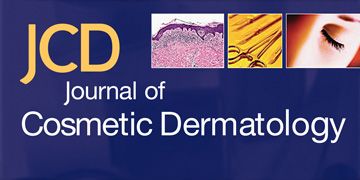
The study was described in a 2017 review article in the Journal of Cosmetic Dermatology. The researchers evaluated the scars at the end of the eight-week treatment as well as four and eight weeks later. They scored the amount of improvement in the scars’ vascularity (blood supply), pliability (skin softness), and levels of pain and itching among other metrics. Scars treated with hypochlorous acid scored better than scars treated with silicone gel on all these criteria.9
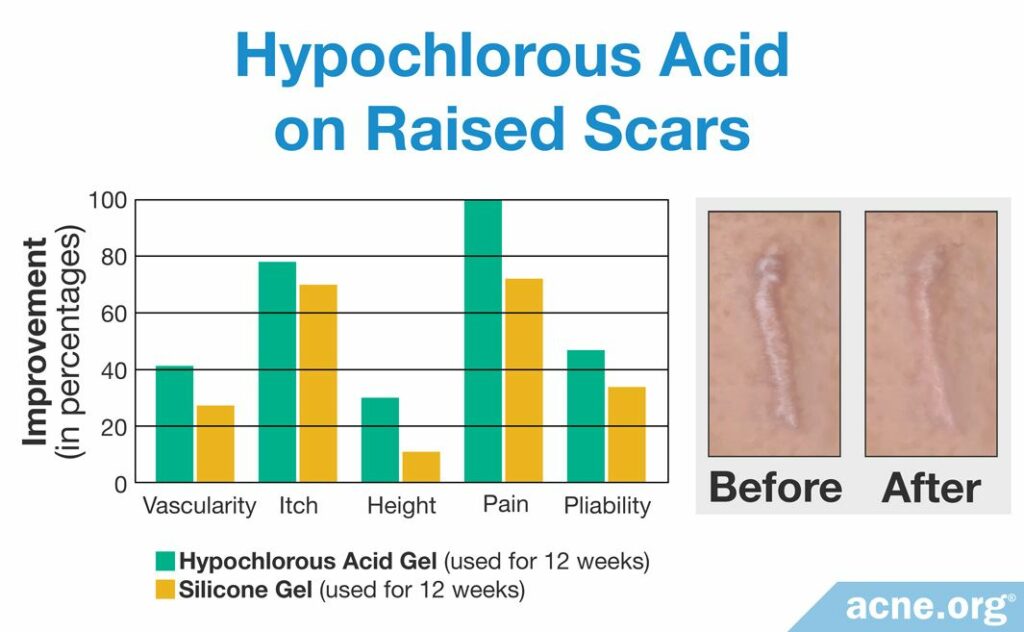
According to a 2020 article written by a panel of experts in dermatology and plastic surgery, hypochlorous acid may one day become the gold standard for reducing scars caused by surgical procedures. While there is little research on hypochlorous acid and scars, the experts agreed that in their experience, hypochlorous acid was useful for minimizing scars, including raised scars.10

In their article in the Journal of Cosmetic Dermatology, the panel members wrote, “[A]s a scar management agent preventing or minimizing aberrant scar development…[hypochlorous acid] could become the first line…antiseptic for supporting wound healing and scar management.”10
Again, while these observations are encouraging, more research is necessary to determine whether hypochlorous acid can help to heal raised acne scars.
Evidence that hypochlorous acid may help relieve itching due to acne
Research in humans and animals has shown that hypochlorous acid can relieve itching caused by rash, which is why the FDA has approved it as a remedy for this condition.11 Mild-to-moderate itching is also a common symptom of acne lesions. For example, one study found that nearly a third of teenagers use medical preparations to reduce itching caused by acne.12
Expand to read details of study

The study was published in the journal Acta Dermato-Venereologica in 2008. The researchers surveyed 108 teenagers with acne and found that 31.5% of the teenagers used medical preparations to reduce itch due to acne lesions.12
Itching in acne is problematic not only because it is unpleasant, but because it can lead to scratching, which can further increase irritation. Irritation, in turn, can make acne worse, contributing to a vicious cycle of more itching and scratching and even more severe acne.
While hypochlorous acid does help relieve itching in other conditions, we have no evidence that it also helps in acne. There simply hasn’t been any research on this topic.
One thing to keep in mind is that hypochlorous acid at certain concentrations can relieve itching, but at higher concentrations it can actually increase itching by causing allergies.13 Therefore, more research is necessary to test specific concentrations of hypochlorous acid on acne lesions.
Expand to read the history of hypochlorous acid
A French chemist discovered hypochlorous acid in 1834.2 During the First World War, doctors used hypochlorous acid for wound disinfection, but it became less popular after the discovery of antibiotics.3
Nowadays, hypochlorous acid functions primarily as a component of household cleaners and bleaches and as a disinfectant in swimming pools. Hospitals and food processing plants also use hypochlorous acid to sanitize surfaces.15,16 In addition, some companies produce hypochlorous acid solutions for the treatment of dermatological conditions and for advanced tissue care.5
Expand to read the chemistry of hypochlorous acid
Hypochlorous acid forms during a chemical reaction that occurs when chlorine dissolves in water. It is a simple molecule consisting of oxygen, chlorine, and hydrogen atoms connected through single bonds, with the chemical formula HOCl.1
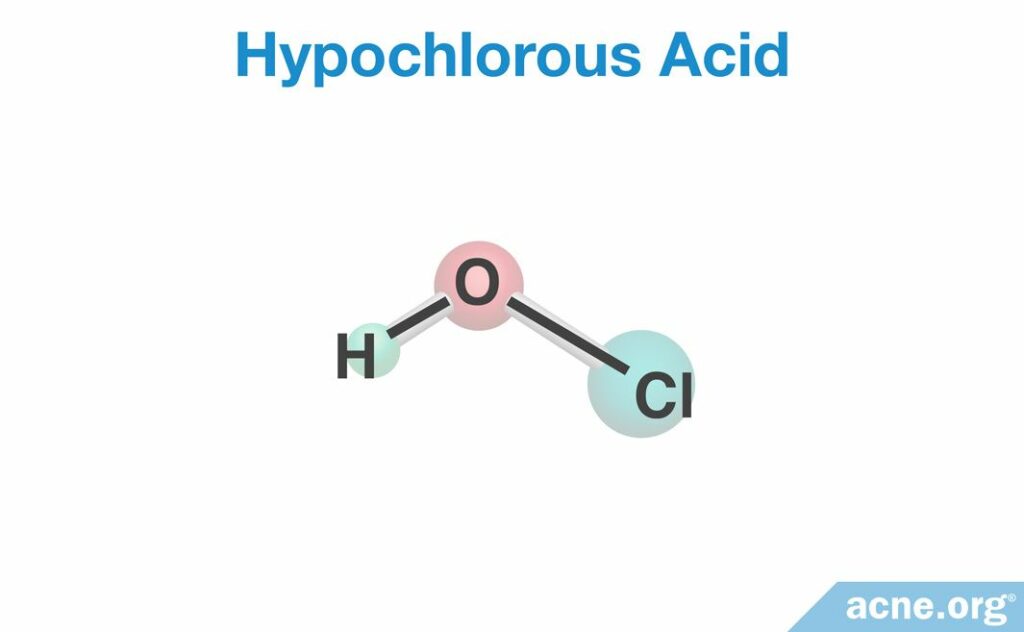
Within the human body, specialized immune cells called neutrophils produce hypochlorous acid as part of the response to an infection by bacteria, viruses, or fungi. The neutrophils first produce hydrogen peroxide or H2O2, and an enzyme called myeloperoxidase converts this chemical into hypochlorous acid.17
When it comes to industrial production, there are three ways of manufacturing hypochlorous acid.18
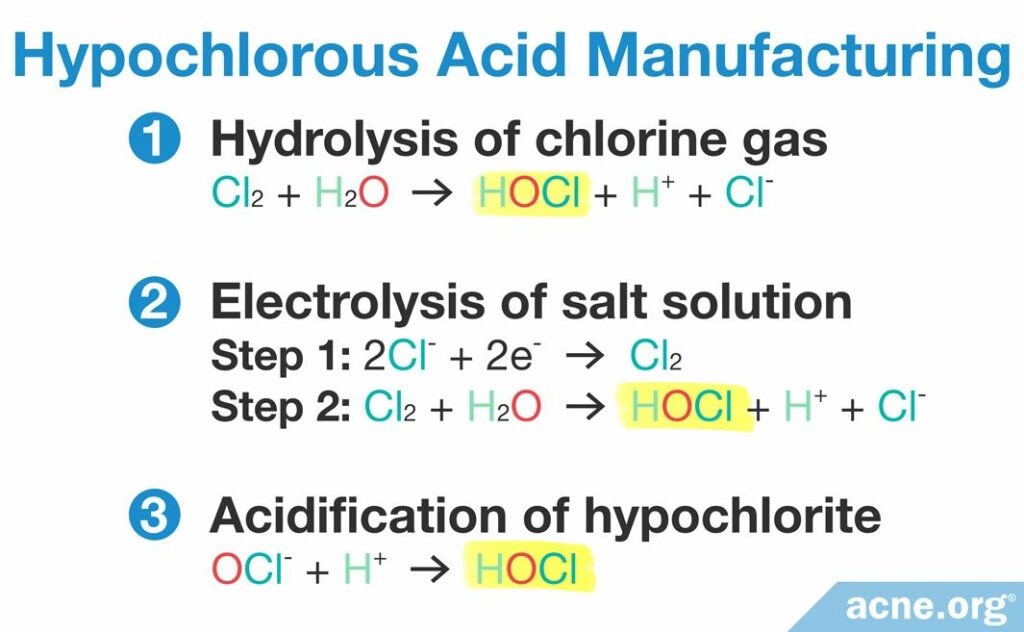
Hypochlorous acid is highly unstable and sensitive to changes in lighting, air quality, acidity, and temperature. Because of this, manufacturers are always researching ways to produce hypochlorous acid so that it retains its efficacy as long as possible.18,19
The Bottom Line
Hypochlorous acid is a chemical that shows promise for the treatment of acne because of its ability to kill bacteria and potential to speed up the healing of lesions and scars and to reduce itching. However, until we have direct research evidence that hypochlorous acid works for acne patients, it is too early to recommend this substance as an acne remedy.
References
- Hypochlorous acid, https://pubchem.ncbi.nlm.nih.gov/compound/hypochlorous_acid
- Hypochlorous acid, https://en.wikipedia.org/wiki/Hypochlorous_acid
- Armstrong, D. G. et al. Expert Recommendations for the Use of Hypochlorous Solution: Science and Clinical Application. Ostomy Wound Manage 61, S2 – S19 (2015). https://www.ncbi.nlm.nih.gov/pubmed/28692424
- Stroman, D. W. et al. Reduction in bacterial load using hypochlorous acid hygiene solution on ocular skin. Clin Ophthalmol 11, 707 – 714 (2017). https://www.ncbi.nlm.nih.gov/pubmed/28458509
- Chapman, I., Hsu, J. T., Stankiewicz, K. & Bhatia, A. C. Use of Hypochlorous Acid as a Preoperative Antiseptic Before Placement of Dermal Fillers: An Alternative to the Standard Options. Dermatol Surg 44, 597 – 599 (2018). https://www.ncbi.nlm.nih.gov/pubmed/28872560
- Anagnostopoulos, A. G. et al. 0.01% Hypochlorous Acid as an Alternative Skin Antiseptic: An In Vitro Comparison. Dermatol Surg 44, 1489 – 1493 (2018). [Epub ahead of print] https://www.ncbi.nlm.nih.gov/pubmed/29985866
- Linfante, A., Allawh, R. M. & Herbert, B. The Role of Propionibacterium acnes Biofilm in Acne Vulgaris. Allen J Clin Exp Dermatol Res 9, 2155 – 9554 (2018). https://www.longdom.org/open-access/the-role-of-propionibacterium-acnes-biofilm-in-acne-vulgaris-2155-9554-1000439.pdf
- Crew, J. et al. NeutroPhase® in chronic non-healing wounds. Int J Burns Trauma 2, 126 – 134 (2012). https://www.ncbi.nlm.nih.gov/pmc/articles/PMC3523395/
- Gold, M. H. et al. Hypochlorous acid gel technology-Its impact on postprocedure treatment and scar prevention. J Cosmet Dermatol 16, 162 – 167 (2017). https://www.ncbi.nlm.nih.gov/pubmed/28370943
- Gold, M. H., Andriessen, A., Bhatia, A. C., Bitter, P. Jr, Chilukuri, S., Cohen, J. L. & Robb, C. Topical stabilized hypochlorous acid: The future gold standard for wound care and scar management in dermatologic and plastic surgery procedures. J Cosmet Dermatol 19, 270-277 (2020). https://www.ncbi.nlm.nih.gov/pubmed/31904191
- Fukuyama, T., Ehling, S., Wilzopolski, J. & Bäumer, W. Comparison of topical tofacitinib and 0.1% hypochlorous acid in a murine atopic dermatitis model. BMC Pharmacol Toxicol 19, 37 (2018). https://www.ncbi.nlm.nih.gov/pubmed/29970189
- Reich, A. et al. Acne itch: do acne patients suffer from itching? Acta Derm Venereol 88, 38 – 42 (2008). https://www.ncbi.nlm.nih.gov/pubmed/18176749
- Pelgrift, R. Y. & Friedman, A. J. Topical Hypochlorous Acid (HOCl) as a Potential Treatment of Pruritus. Curr Dermatol Rep 2, 181 – 190 (2013). https://link.springer.com/article/10.1007/s13671-013-0052-z
- Burian, E. A., Sabah, L., Kirketerp-Møller, K., Gundersen, G. & Ågren, M. S. Effect of stabilized hypochlorous acid on re-epithelialization and bacterial bioburden in acute wounds: A randomized controlled trial in healthy volunteers. Acta Derm Venereol 102, adv00727 (2022). https://pubmed.ncbi.nlm.nih.gov/35578822/
- McKenna, S. M. & Davies, K. J. The inhibition of bacterial growth by hypochlorous acid. Possible role in the bactericidal activity of phagocytes. Biochem J 254, 685 – 92 (1988). https://www.ncbi.nlm.nih.gov/pubmed/2848494
- Zwiener, C. et al. Drowning in disinfection byproducts? Assessing swimming pool water. Environ Sci Technol 41, 363 – 72 (2007). https://www.ncbi.nlm.nih.gov/pubmed/17310693
- Pullar, J. M., Vissers, M. C. & Winterbourn, C. C. Living with a killer: the effects of hypochlorous acid on mammalian cells. IUBMB Life 50, 259 – 66 (2000). https://www.ncbi.nlm.nih.gov/pubmed/11327319
- Eryilmaz, M. & Palabiyik, I. M. Hypochlorous Acid – Analytical Methods and Antimicrobial Activity. Tropical J Pharm Res 12, 1 (2013). https://www.ajol.info/index.php/tjpr/article/view/86198
- Ishihara, M. et al. Stability of Weakly Acidic Hypochlorous Acid Solution with Microbicidal Activity. Biocontrol Sci 22, 223 – 227 (2017). https://www.ncbi.nlm.nih.gov/pubmed/29279579
The post Hypochlorous Acid: What Is It, and Can It Help with Acne? appeared first on Acne.org.









